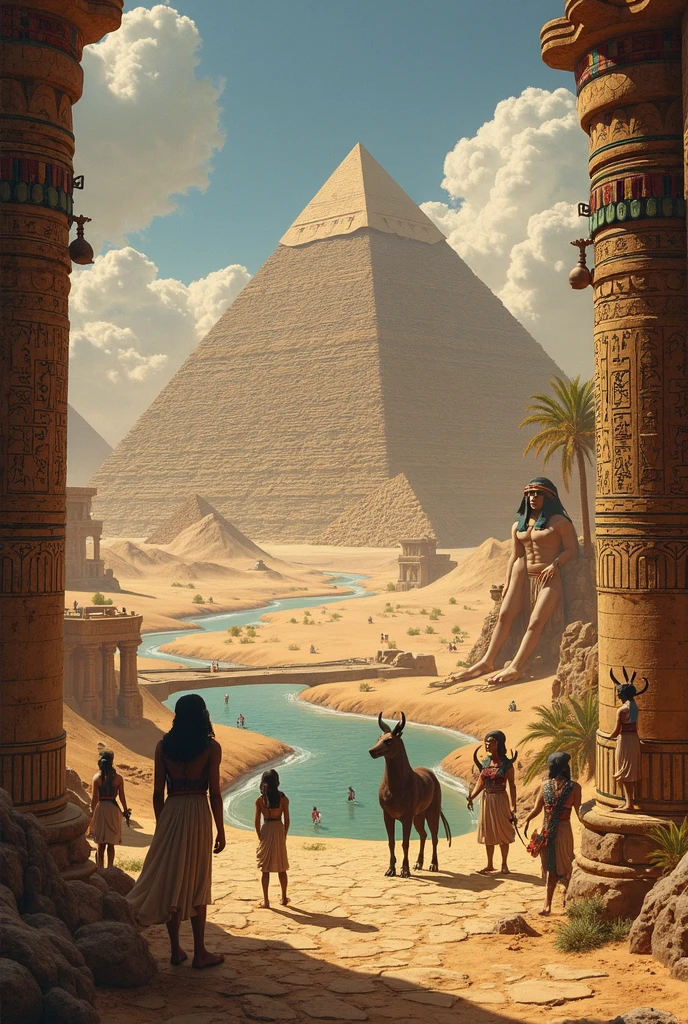Japanese Mythology: The Divine Tales of Amaterasu and Beyond
Japanese mythology is a rich tapestry of gods, spirits, and legendary creatures that have shaped the cultural and spiritual identity of Japan. At the heart of these myths stands Amaterasu, the radiant sun goddess, whose influence extends beyond religion into daily life. Alongside her, figures like Susanoo, the storm god, and Izanagi, the creator deity, weave a complex narrative of creation, conflict, and harmony.
The Creation Myth: Izanagi and Izanami
According to Japanese mythology, the world began with the divine couple Izanagi and Izanami. They stirred the primordial ocean with a jeweled spear, creating the islands of Japan. Their union gave birth to countless Kami (spirits or deities), including the three most revered: Amaterasu, Susanoo, and Tsukuyomi, the moon god.
Key Deities in the Creation Myth
| Deity | Domain | Significance |
|---|---|---|
| Izanagi | Creation | Father of the gods |
| Izanami | Death | Mother of the gods |
| Amaterasu | Sun | Supreme goddess |
| Susanoo | Storms | God of chaos |
Amaterasu: The Sun Goddess
Amaterasu, the goddess of the sun, is one of the most important figures in Japanese mythology. She represents light, fertility, and the imperial lineage of Japan. Her most famous legend involves her retreat into a cave, plunging the world into darkness, only to be lured out by the other gods.
The Tale of Amaterasu’s Retreat
- Susanoo wreaks havoc in heaven, angering Amaterasu.
- She hides in the Ama-no-Iwato cave, depriving the world of light.
- The gods devise a plan involving a mirror and a dance to lure her out.
- Amaterasu emerges, restoring light to the world.
Susanoo: The Storm God
Susanoo, the brother of Amaterasu, is a complex figure embodying both destruction and protection. After being banished from heaven, he slays the eight-headed serpent Yamata-no-Orochi, earning a place among the revered Kami.
Susanoo’s Feats and Symbols
- Defeated Yamata-no-Orochi with cunning and bravery.
- Discovered the sacred sword Kusanagi-no-Tsurugi.
- Worshipped as a protector against natural disasters.
The Kami: Spirits of Nature
In Japanese mythology, Kami are spirits inhabiting natural phenomena, objects, and ancestors. They range from benevolent deities like Amaterasu to mischievous entities like the Yokai.
Types of Kami
| Type | Description | Example |
|---|---|---|
| Celestial Kami | Deities of heaven | Amaterasu |
| Earthly Kami | Spirits of nature | Inari (rice god) |
| Ancestral Kami | Deified ancestors | Clan founders |
Yokai: The Supernatural Beings
Unlike the noble Kami, Yokai are supernatural creatures that range from harmless tricksters to malevolent monsters. They populate Japanese folklore, adding depth to the mythological landscape.
Famous Yokai in Japanese Mythology
- Tengu – Bird-like demons with supernatural powers.
- Kitsune – Fox spirits known for their intelligence.
- Oni – Ogre-like creatures symbolizing evil.
The Influence of Japanese Mythology Today
Japanese mythology remains deeply embedded in modern culture, influencing everything from festivals to pop media. The legacy of Amaterasu and other deities continues to inspire art, literature, and even video games.
For further reading, explore these resources: Encyclopedia Britannica on Amaterasu, Japan Guide on Shinto Mythology, and Mythopedia’s Japanese Mythology Section.
Descubre más artículos fascinantes sobre mitología y cultura japonesa en nuestra web y síguenos en facebook.com/zatiandrops.
One of the most pivotal figures bridging the divine and mortal realms in Japanese mythology is Ninigi-no-Mikoto, grandson of Amaterasu. Sent to earth to establish order, his descent from the heavens (Tenson kōrin) marks the beginning of Japan’s imperial lineage. According to the Kojiki, Amaterasu bestowed upon him three sacred treasures:
- Yata no Kagami – The divine mirror that lured her from the cave.
- Kusanagi-no-Tsurugi – The sword Susanoo retrieved from Yamata-no-Orochi.
- Yasakani no Magatama – A jewel symbolizing benevolence.
These treasures, still revered today, symbolize the emperor’s divine right to rule. Ninigi’s marriage to Konohanasakuya-hime, the blossom princess, further ties the gods to nature’s cycles.
The Tragic Tale of Konohanasakuya-hime
Konohanasakuya-hime, goddess of Mount Fuji and cherry blossoms, embodies fragility and resilience. When her fidelity was doubted by Ninigi, she proved her purity by entering a burning hut and emerging unscathed with their children. This myth explains volcanic activity and the fleeting beauty of sakura blossoms.
Symbolism in the Myth
| Element | Meaning |
|---|---|
| Fire | Transformation and purification |
| Blossoms | Life’s ephemeral nature |
| Volcanoes | Divine wrath and renewal |
Unlike Western hells, Yomi in Japanese mythology is a shadowy realm where souls dwell after death. Izanagi’s failed attempt to rescue Izanami from Yomi birthed taboos around death and decay. Key features of Yomi include:
- Rotting Landscapes – Food turns to maggots; light is absent.
- Shikome – Hideous female spirits pursuing the living.
- Eternal Separation – Izanami’s curse ensures no return.
Emma-Ō: The Japanese Judge of the Dead
Under Buddhist influence, Emma-Ō (Yama) became the ruler of Yomi, judging souls based on their karma. Depicted with a scowling face and red robes, he oversees the Rokudō (Six Realms of Rebirth).
The Six Realms of Rebirth
| Realm | Description |
|---|---|
| Deva | Gods; temporary bliss |
| Asura | Demigods; constant strife |
| Human | Moral choices determine fate |
| Animal | Instinct-driven suffering |
| Preta | Hungry ghosts; unfulfilled desires |
| Naraka | Hell; punishment for sins |
Beyond the central pantheon, Japan’s regions venerate unique Kami tied to local geography. For example:
- Ryūjin – Dragon god of the sea, worshipped by fishermen in Shikoku.
- Oyamatsumi – Mountain god sibling of Amaterasu, revered in Hokkaido.
- Hachiman – War deity turned protector, enshrined at Usa Jingū.
The Heroic Yamato Takeru
Blending myth and history, Yamato Takeru is a tragic warrior prince. Armed with the Kusanagi sword, he subdued rebellions but died cursing his fate. His spirit transformed into a white bird, symbolizing restless souls in Shinto belief.
Japanese myths thrive in annual festivals (matsuri). Notable examples include:
Major Mythological Festivals
| Festival | Deity Honored | Significance |
|---|---|---|
| Gion Matsuri | Susanoo | Purification from plagues |
| Niiname-sai | Amaterasu | Harvest thanksgiving |
| Setsubun | Oni | Driving away evil spirits |
Kagura: Sacred Dance of the Gods
Performed at shrines, Kagura reenacts myths like Amaterasu’s cave story. Dancers wear masks representing Kami, using music and motion to invoke divine presence.
From Studio Ghibli’s Princess Mononoke to games like Okami, Japanese myths inspire globally. Key adaptations include:
- Inari – Fox deities appear in Naruto as summon creatures.
- Yokai – GeGeGe no Kitarō popularizes spirits like Nurarihyon.
- Izanagi/Izanami – Central to Persona 4’s storyline.
For deeper exploration, visit: KCP International’s Cultural Guides, Tofugu’s Mythology Breakdown, and Ancient.eu on Shinto-Buddhist Syncretism.
Descubre más artículos fascinantes sobre mitología y cultura japonesa en nuestra web y síguenos en facebook.com/zatiandrops.
The Legend of Momotaro: The Peach Boy
One of Japan’s most beloved folktales, Momotaro (Peach Boy), blends mythology with moral lessons. Born from a giant peach, he grows into a hero who defeats Oni (demons) with the help of animal allies—a dog, monkey, and pheasant. This story symbolizes courage, teamwork, and the triumph of good over evil.
Symbolic Elements in Momotaro’s Tale
| Element | Meaning |
|---|---|
| Peach | Longevity and divine favor |
| Oni Island | Chaos and moral corruption |
| Animal Allies | Harmony between humans and nature |
The Myth of Urashima Taro: A Cautionary Tale
The story of Urashima Taro, a fisherman who saves a turtle and is rewarded with a visit to the underwater palace Ryūgū-jō, explores themes of time and temptation. After returning to his village with a mysterious box, he opens it and ages instantly, learning that centuries had passed in his absence.
Key Lessons from Urashima Taro
- Respect for Boundaries – The box symbolizes forbidden knowledge.
- Illusion of Time – Divine realms operate outside mortal laws.
- Gratitude vs. Greed – His curiosity overrides gratitude.
The Role of Animals in Japanese Mythology
Animals in Japanese myths often serve as messengers, guardians, or transformative beings. For example:
- Komainu – Lion-dog statues protecting shrines.
- Bakeneko – Shape-shifting cats with supernatural powers.
- Hakutaku – A beast that exposes evil spirits.
Sacred Animals and Their Deities
| Animal | Associated Kami | Role |
|---|---|---|
| Fox (Kitsune) | Inari | Messenger of fertility |
| Dragon (Ryū) | Ryūjin | Water and rain deity |
| Crow (Yatagarasu) | Amaterasu | Divine guide |
The Myth of the Heavenly Rock Boat
In one lesser-known tale, Amaterasu and Susanoo reconcile by creating a boat from a celestial rock. This myth underscores the balance between light (sun) and chaos (storms), reflecting Shinto’s emphasis on harmony (wa).
Cultural Interpretations
- Boat Symbolism – Represents safe passage through life’s turmoil.
- Rock as Purity – Unyielding and eternal, like the gods.
- Reconciliation – Even opposing forces can coexist.
The Seven Lucky Gods (Shichifukujin)
Blending Shinto, Buddhist, and Hindu traditions, the Shichifukujin are deities of prosperity. They travel on a treasure ship (Takarabune) during New Year, bringing luck to believers.
Profiles of the Seven Lucky Gods
| Deity | Origin | Blessing |
|---|---|---|
| Ebisu | Shinto | Fishing and commerce |
| Daikokuten | Buddhist | Wealth and agriculture |
| Benzaiten | Hindu | Arts and wisdom |
The Myth of the Bamboo Cutter (Taketori Monogatari)
Japan’s oldest surviving folktale, Taketori Monogatari, tells of Princess Kaguya, a moon being raised on Earth. Her celestial origins and eventual return to the moon explore themes of transience and unattainable beauty.
Symbolism in the Tale
- Bamboo – Represents resilience and spiritual growth.
- Moon – A realm beyond human reach.
- Five Suitors – Symbolize futile earthly desires.
Mythological Landscapes in Japan
Many real locations are tied to myths, such as:
- Amanohashidate – The “Bridge to Heaven” from Izanagi’s spear.
- Mount Osore – Gateway to Yomi, resembling hellish landscapes.
- Itsukushima Shrine – Dedicated to Susanoo’s daughter, Benzaiten.
Sacred Sites and Their Stories
| Location | Mythological Connection |
|---|---|
| Izumo Taisha | Meeting place of the Kami each year |
| Fuji Five Lakes | Formed by Susanoo’s tears |
| Yomotsu Hirasaka | Slope separating Yomi from the living |
For further exploration, visit: Japan Travel’s Mythological Sites, Kyoto National Museum’s Artifacts, and Full Text of the Kojiki.
Descubre más artículos fascinantes sobre mitología y cultura japonesa en nuestra web y síguenos en facebook.com/zatiandrops.
The Legend of Kintaro: The Golden Boy
Another beloved folk hero, Kintaro (Golden Boy), showcases Japan’s reverence for superhuman strength and purity. Raised by a mountain witch, he befriends animals and wrestles bears, embodying the ideal of harmony between humans and nature. His story later merged with samurai lore, as he grew up to become the warrior Sakata no Kintoki.
Kintaro’s Symbolic Attributes
| Symbol | Meaning |
|---|---|
| Golden Axe | Divine strength and purity |
| Animal Companions | Connection to primal forces |
| Red Body | Vitality and supernatural origin |
The Myth of Ame-no-Uzume: The Dawn Goddess
While Amaterasu dominates solar mythology, her counterpart Ame-no-Uzume plays a crucial role as the goddess of dawn and revelry. Her erotic dance that lured Amaterasu from the cave established her as the patron of performing arts and humor.
Ame-no-Uzume’s Lasting Influence
- Kagura Dance – Originated from her divine performance
- Comedy Traditions – Considered the first comedian in Japanese lore
- Fertility Rites – Her dance symbolizes creative energy
The Tale of the Jorogumo: The Spider Woman
Among Japan’s most terrifying Yokai, the Jorogumo (prostitute spider) lures men with her beauty before revealing her true arachnid form. This myth warns against superficial attraction and hidden dangers.
Jorogumo Characteristics
| Trait | Symbolism |
|---|---|
| Beautiful Woman | Deceptive appearances |
| Spider Legs | Entrapment and predation |
| Shamisen Playing | Seduction through art |
The Legend of the Tanuki: Shape-shifting Tricksters
Unlike Western raccoons, Japanese Tanuki are magical creatures known for their shape-shifting abilities and enormous testicles (symbolizing good fortune). These jovial spirits appear in countless folktales as both helpers and pranksters.
Famous Tanuki Tales
- The Bunbuku Chagama – A tanuki transforms into a teapot
- Tanuki vs. Kitsune – Rivalry with fox spirits
- Statue Legends – Many temples claim their tanuki statues come alive at night
The Myth of the Heavenly Jeweled Spear
The Ame-no-Nuboko, the spear used by Izanagi and Izanami to create Japan, remains one of mythology’s most powerful artifacts. Some shrines claim to possess fragments of this divine tool, though its current location remains a mystery.
The Spear’s Symbolic Dimensions
| Aspect | Interpretation |
|---|---|
| Jeweled Tip | Divine authority |
| Stirring Motion | Creative chaos |
| Primordial Waters | Potential before form |
The Story of Hoderi and Hoori: Brothers of Land and Sea
These divine brothers represent the eternal conflict between terrestrial and maritime cultures. When fisherman Hoderi loses his brother Hoori’s fishing hook, their quarrel leads to an undersea adventure involving the palace of Ryūjin.
Themes in the Brothers’ Tale
- Reciprocity – The importance of returning borrowed items
- Elemental Balance – Land and sea as complementary forces
- Ancestral Connections – Their descendants include Japan’s first emperors
The Legend of the Crane Wife
This poignant tale tells of a man who marries a crane in human form. When he breaks his promise not to watch her weave, she reverts to bird form and flies away, illustrating themes of trust and the consequences of broken vows.
Crane Wife Symbolism
| Element | Meaning |
|---|---|
| Crane | Fidelity and sacrifice |
| Weaving | Creation and deception |
| Forbidden Viewing | Human curiosity vs. supernatural boundaries |
For deeper exploration of these myths, visit: Japanese Mythology Research Center, Yokai Encyclopedia, and Guide to Shinto Sacred Sites.
Descubre más artículos fascinantes sobre mitología y cultura japonesa en nuestra web y síguenos en facebook.com/zatiandrops.


